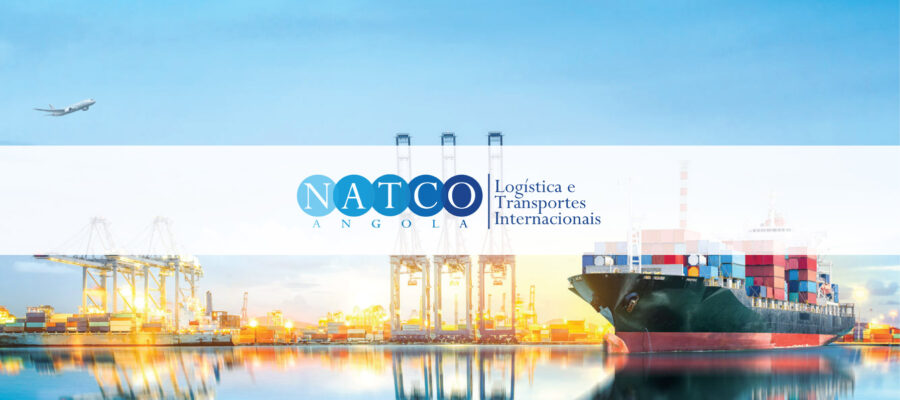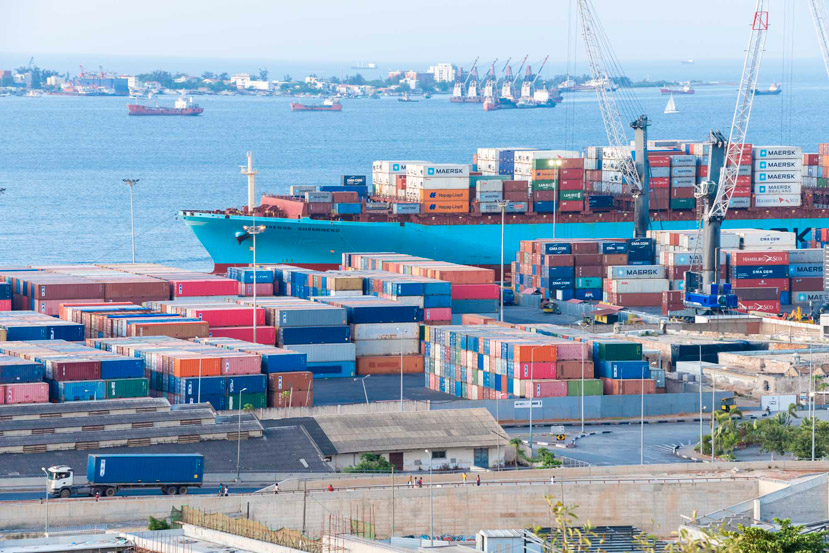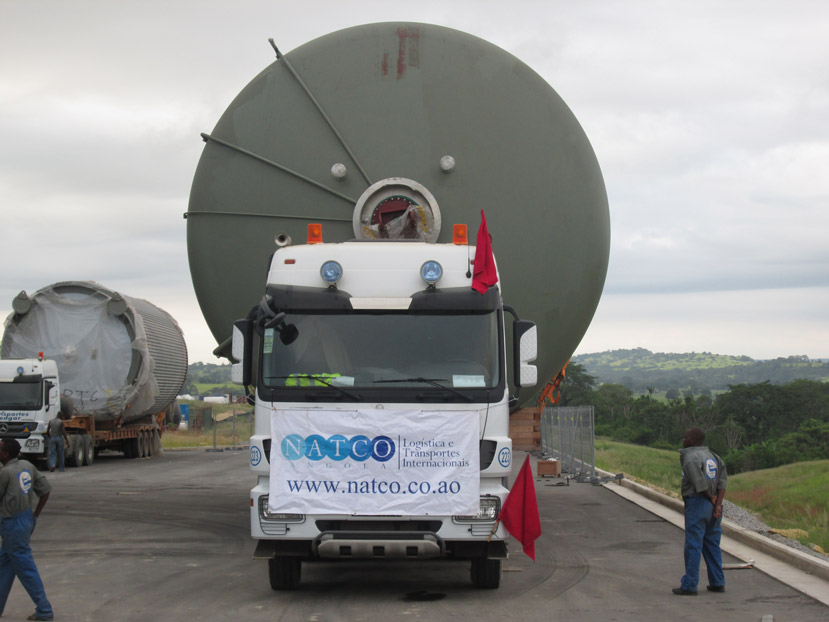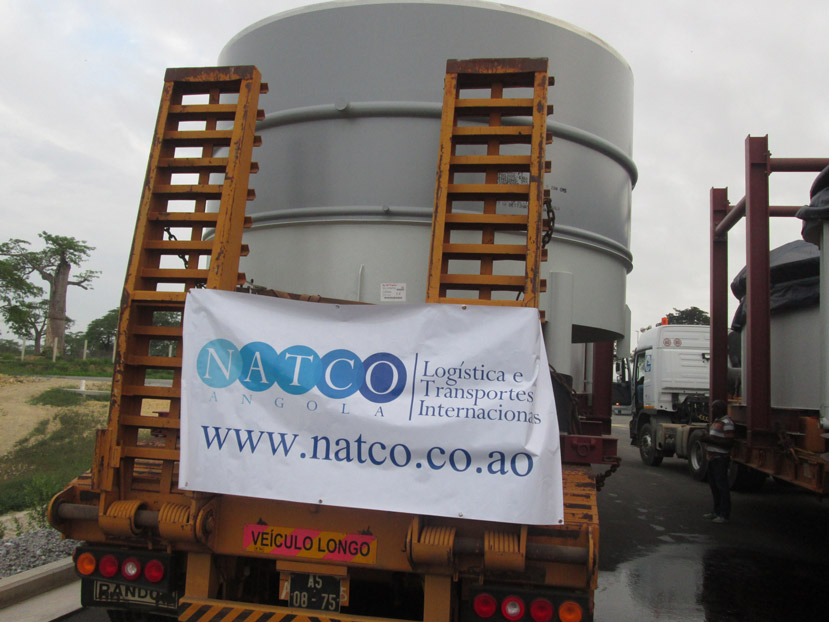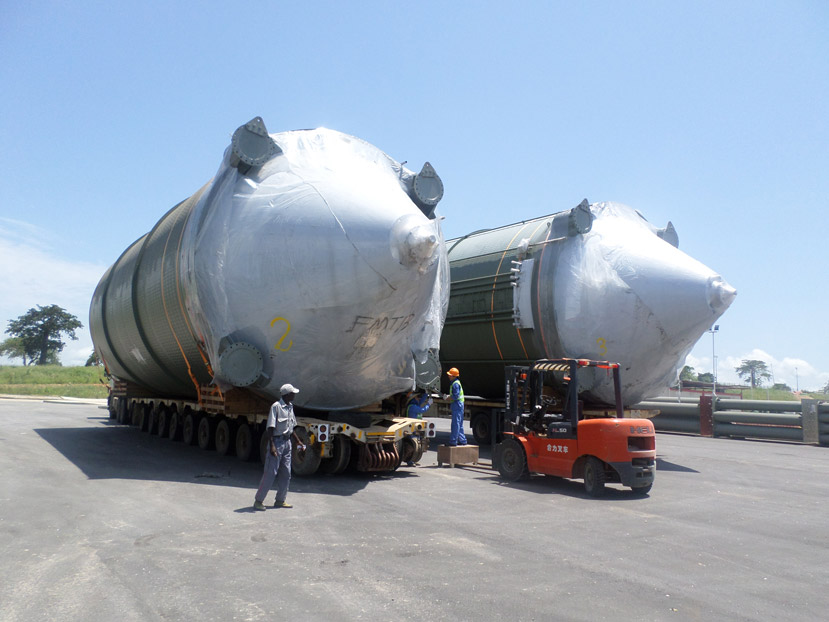Interview with
Mr. Carlos Magalhaes
President

See key takeaways of this interview at the end.
First of all Carlos, can you introduce yourself to our readers? When did you start your career in shipping & logistics, and for how long have you been living in Angola?
My name is Carlos Magalhães, and I currently serve as President of NATCO Angola. I’ve been working in the shipping and logistics industry for over 40 years. I pursued my studies in Switzerland, and, throughout my career, I’ve held senior leadership roles in several countries across different continents.
I moved to Angola more than 25 years ago, and since then, I’ve been fully committed to supporting the country’s development through logistics — particularly in sectors such as oil and gas, infrastructure, and heavy industry, where supply chain precision and reliability are absolutely vital.
In addition to my role at NATCO, I also serve on the boards of several companies, where I contribute to strategic planning, governance, and long-term growth initiatives. Since 2023, I’ve had the honor of serving as President of the Swiss Business Council in Angola, a position that allows me to actively promote economic cooperation between Switzerland and Angola. This includes facilitating investment opportunities and building commercial partnerships that contribute to sustainable, long-term development for both countries.
How is the political situation in Angola at the moment? It’s a country we don’t hear so much about these days – all I know, for instance, is that it’s a major player in oil and gas, which also means a lot of shipping, right?
Yes, that’s absolutely right – Angola is indeed a major player in the oil and gas sector, and that naturally drives a lot of activity in the shipping and logistics space. But beyond that, Angola has actually gone through quite a meaningful political and economic transformation over the past few years.
Under President João Lourenço, the government has prioritized anti-corruption reforms, economic diversification, and the attraction of foreign investment. And this year, 2025, Angola took on the rotating presidency of the African Union, which I believe is a strong signal of the country’s growing influence and stability in the region.
While oil and gas remain the backbone of the economy — with production expected to stay around 1.1 million barrels per day through at least 2027 — we’re seeing strong momentum in other sectors such as agriculture, mining, and industry. All of these depend on reliable and efficient logistics infrastructure.
The shipping sector is evolving rapidly. The Port of Luanda, which handles over 80% of the country’s trade, is being expanded with a new container terminal. Meanwhile, Lobito is emerging as a strategic logistics hub thanks to the Lobito Corridor and the new railway links connecting Angola to inland markets in the DRC and Zambia. Namibe is also undergoing upgrades to accommodate larger vessels and a broader range of cargo.
All of these developments are positioning Angola as a critical logistics and trade gateway in Southern Africa. For companies like ours — and for our clients — this creates exciting opportunities for growth and long-term partnerships in a region that’s clearly on the move.
What can you tell our readers about NATCO, both in Angola and internationally? Where is the company headquartered, and could you elaborate a bit on the company’s history?
NATCO Angola is part of a global logistics network that originally started in Switzerland. The NATCO brand itself has been around for over 40 years — the first office opened in Switzerland, and from there the company gradually expanded into multiple continents. We’ve built our reputation on managing project cargo, heavy lifts, and complex logistics operations, particularly in challenging and developing markets.
Here in Angola, our headquarters is based in Luanda, but we operate nationwide. We’ve been active in the country for 25 years, and over that time, we’ve developed a strong understanding of the local landscape — from customs and compliance to infrastructure and regional constraints. What really sets us apart is our ability to combine deep local knowledge with international standards, ensuring that our clients benefit from world-class execution, even in the most demanding environments.
Today, we’re proud to be part of the ILS Group – International Logistics Solutions, which is also headquartered in Switzerland. Being a member of ILS gives us access to global resources, shared expertise, and a powerful network of partners. This has allowed us to strengthen our offering not only within Angola but across the wider region as well.
Our commitment has always been to deliver tailor-made logistics solutions with precision, flexibility, and transparency — whether it’s for oil and gas, infrastructure, mining, or other sectors operating in Angola and beyond.
Which ports are mainly used in Angola for shipping? Any specific comments on the ports – i.e., which ones might be better for handling project and OOG cargo?
In Angola, we work across several key ports, each with its own strategic importance depending on the type of cargo and the region being served. The Port of Luanda is definitely the country’s primary gateway — it handles the largest volume of imports and exports. Thanks to its robust infrastructure and operational capacity, it remains the preferred option for project cargo and out-of-gauge (OOG) shipments, particularly for cargo headed to the capital or the surrounding industrial areas.
That said, the Port of Lobito is quickly emerging as a major logistics hub, especially for central Angola and the mining industry. With the development of the Lobito Corridor, including the new rail link connecting to the DRC [Democratic Republic of the Congo, Ed.] and Zambia, it’s becoming increasingly valuable for cross-border trade and the export of critical minerals.
The Port of Namibe, although smaller in scale, is currently undergoing modernization and plays an important role in supporting logistics in Angola’s southern provinces, particularly for bulk and breakbulk cargo.
We’re also seeing notable progress at the Port of Cabinda, where investment tied to the new oil refinery project is stimulating industrial and logistics growth. This will be transformative for the enclave, which has historically been somewhat isolated in terms of infrastructure.
Lastly, the Port of Soyo is a key hub for the oil and gas sector. It supports offshore operations and provides vital logistics services to upstream projects in northern Angola. We’re very active there as well, especially in base-to-base movements and support for offshore installations.
In summary, while Luanda remains the go-to port for large-scale and complex cargo, Lobito, Cabinda, and Soyo are becoming increasingly important in Angola’s evolving infrastructure and energy landscape. At NATCO Angola, we adapt our port strategy based on project requirements, cargo profile, and final destination — always aiming for the most efficient and cost-effective routing.
Could you provide us with some details of any projects you have handled to or from Angola recently (air or sea)?
Certainly. At NATCO Angola, we’ve been at the forefront of managing complex logistics operations for major industrial and infrastructure projects throughout the country — by both air and sea.
One particularly notable project was the import and delivery of a complete yogurt factory from Germany to Catumbela, via the Port of Lobito. We handled the full DDP scope — from port operations and customs clearance to inland transport and final positioning of the equipment. The operation involved extremely sensitive movements through the city centers of Lobito and Catumbela, which meant we had to obtain special permits, arrange police escorts, and coordinate closely with utility companies to manage infrastructure constraints like low-hanging cables and narrow roads.
Another significant project was the Sodiba Brewery in Bom Jesus. We were responsible for transporting over 5,000 m³ of brewery equipment — much of it out-of-gauge and heavy-lift cargo. The final leg of the journey required us to navigate through central Luanda under escort and then move onto a dirt road to reach the construction site. That part involved precise crane operations and careful discharge sequencing to ensure everything was positioned correctly and safely.
We also handled the complete logistics for a cement factory, again from Germany to Bom Jesus. That was a turnkey operation involving heavy-lift and OOG cargo, full coordination from supplier to job site, customs clearance, secure inland transport, and the final on-site delivery and positioning of very sensitive industrial components.
In addition, we’ve carried out several helicopter transport operations — including Sikorsky, Super Puma, and Agusta models — using both sea and air freight. Some of these shipments involved full air charters, like the AN124, for urgent deliveries out of Europe and the Middle East. On arrival in Angola, we had to plan night-time convoys through city centers with police escorts and utility company support due to the sheer size and delicate nature of the cargo.
These projects really showcase the breadth of our capabilities at NATCO Angola. We don’t just move freight — we deliver integrated, end-to-end logistics solutions under some of the most challenging conditions, always ensuring full compliance, safety, and efficiency from origin to final destination.
How about customs clearance in Angola? Is it difficult — anything particular to be aware of?
Customs clearance in Angola has certainly improved in recent years, especially with the government’s efforts to digitize and streamline the process. That said, it remains an area that requires deep local expertise and constant coordination. Importers need to be very attentive when it comes to documentation, proper classification, and staying on top of regulatory changes — which are frequent. Having a trusted local partner who knows how to navigate these procedures is key to avoiding delays and unnecessary costs.
At NATCO Angola, we’ve been working in this space for over two decades, and customs clearance has become one of our core strengths. We manage the entire process internally, from import and export procedures to temporary imports and re-exports, including specialized regimes for the oil and gas sector. We also handle vessel clearances and assist with import licensing and exemptions.
From my experience, the most important factor is preparation. If everything is aligned before the cargo arrives — the paperwork, permits, exemptions — then things can move quickly. In fact, we’ve successfully cleared complex and oversized cargo in as little as 24 hours. So while Angola’s customs environment can be challenging, with the right experience and relationships, it’s absolutely manageable.
Are there any shipping lines that you particularly recommend or DON’T recommend using into Angola?
We work regularly with most of the major international shipping lines serving Angola, including Maersk, MSC, CMA CGM, and others. These carriers have proven to be reliable partners for a wide range of cargo types and origins, and we’ve developed strong operational relationships with them over the years.
That said, I wouldn’t say we recommend or blacklist specific shipping lines outright. Rather, we assess each shipment on a case-by-case basis — considering the cargo profile, point of origin, required transit time, and destination port. The choice of carrier really depends on the specifics of the project. What works well for one shipment might not be the best fit for another, so we always aim to select the line that best meets the unique requirements of each operation.
As part of our commitment to quality, NATCO Angola is ISO 9001 certified, which means we are required to regularly evaluate and document the performance of our service providers — including shipping lines. We assess them not only on transit times and pricing, but also on documentation accuracy, consistency, handling quality at destination, and responsiveness when challenges arise.
This process ensures that we maintain a high standard of service across all our operations, and it helps us make informed decisions when recommending carriers to our clients. Ultimately, our role is to find the most efficient and reliable solution for each project — and that’s where this kind of structured evaluation really adds value.
How do you view the business from a logistics perspective for the rest of this year?
I’m quite optimistic about the logistics landscape for the remainder of the year. There’s growing movement across several key sectors — from oil and gas to mining and infrastructure — and that naturally drives demand for sophisticated, reliable logistics solutions.
We’re especially proud to have secured one of the largest logistics projects in Angola in terms of volume, which we’ll be starting shortly. The contracts are already signed, and we’re now in the final planning stages, preparing to launch operations. It’s a major milestone for us and a clear sign that Angola continues to attract large-scale industrial activity.
Beyond that, we’re seeing Angola positioning itself more and more as a regional logistics hub. The Lobito Corridor is a great example — linking the Atlantic coast to inland markets in the DRC and Zambia and creating major opportunities for cross-border movements. But it’s not just about rail — the new Dr. António Agostinho Neto International Airport, scheduled to begin operations soon, will also be a game-changer. It will enhance Angola’s role as an air cargo gateway for the region.
Of course, there are still global challenges — from freight rate volatility to supply chain disruptions — but with the right structure, adaptability, and experienced partners, I believe Angola is entering a very promising phase. At NATCO, we’re ready to support that growth with tailored, end-to-end logistics solutions built on trust, local expertise, and international standards.
How would it be best for our readers to get in touch with you?
The best way to reach us is through our website www.natco.co.ao. There, you’ll find an overview of our services, project experience, and all the relevant contact details. For direct communication, you can also reach our team at info@natco.co.ao.
On social media, we’re represented through our parent company, the ILS Group Switzerland, which shares updates, industry insights, and project highlights across the network. You can follow us on LinkedIn and Instagram under ILS Group Switzerland — it’s a great way to stay connected and see what we’re working on, not just in Angola, but globally.
We’re always open to new collaborations and conversations. Whether you’re planning a project in Angola or just looking to understand the logistics landscape better, we’ll be happy to connect.”
Key Takeaways
- Logistics Veteran Driving Angola’s Growth
Carlos Magalhães, President of NATCO Angola, brings over 40 years of global logistics experience, having lived in Angola for 25 years. He’s played a vital role in supporting development in oil, gas, infrastructure, and heavy industry — while also leading initiatives like the Swiss Business Council to foster international investment. - Angola Emerges as Regional Logistics Powerhouse
Angola is undergoing major transformation. Political reforms, oil sector strength, and infrastructure investments like the Lobito Corridor and expanded port terminals are boosting its logistics capabilities, positioning the country as a key gateway in Southern Africa. - NATCO Angola Delivers Complex Projects with Precision
From transporting full yogurt and cement factories to airlifting helicopters via AN124 charters, NATCO Angola handles end-to-end logistics across air, sea, and land. Their deep local expertise ensures high-risk, oversized cargo is delivered safely and efficiently. - Strategic Use of Ports Enhances Supply Chain Efficiency
Luanda remains Angola’s main hub for OOG and project cargo, but ports like Lobito, Namibe, Cabinda, and Soyo are rising in relevance. NATCO tailors port usage to project needs — balancing capacity, geography, and infrastructure. - Customs Clearance Success Hinges on Preparation
Angola has made strides in customs modernization, but regulatory complexity persists. NATCO’s in-house expertise allows them to navigate the system efficiently — sometimes clearing oversized cargo in under 24 hours. Planning and documentation remain essential. - Angola’s Logistics Outlook Remains Strong for 2025
Carlos Magalhães is optimistic about Angola’s logistics sector, with major projects underway and infrastructure like the new international airport boosting capacity. Despite global challenges, Angola’s strategic location and growing industrial demand are setting the stage for sustained growth — and NATCO is gearing up to lead that momentum.

